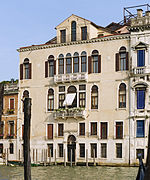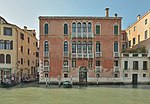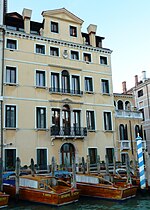Museo di Palazzo Mocenigo
1985 establishments in ItalyFashion museums in ItalyMuseums established in 1985Museums in VenicePalaces in Sestiere Santa Croce ... and 1 more
Textile museums

The Museo di Palazzo Mocenigo (aka Palazzo Mocenigo di San Stae) is a palazzo near the Church of San Stae, south of the Grand Canal in the sestiere of Santa Croce in Venice, Italy. It is now a museum of fabrics and costumes, run by the Fondazione Musei Civici di Venezia.
Excerpt from the Wikipedia article Museo di Palazzo Mocenigo (License: CC BY-SA 3.0, Authors, Images).Museo di Palazzo Mocenigo
Calle Mocenigo Cà Vecchia, Mestre Venezia-Murano-Burano
Geographical coordinates (GPS) Address Nearby Places Show on map
Geographical coordinates (GPS)
| Latitude | Longitude |
|---|---|
| N 45.434722222222 ° | E 12.328611111111 ° |
Address
Palazzi Mocenigo
Calle Mocenigo Cà Vecchia
30170 Mestre, Venezia-Murano-Burano
Veneto, Italy
Open on Google Maps










